Optical Fiber Temperature and Torsion Sensor Based on Lyot-Sagnac Interferometer
Abstract
:1. Introduction
2. Operation Principle
3. Experiment and Results
4. Conclusions
Acknowledgments
Author Contributions
Conflicts of Interest
References
- Liu, Y.; Liu, B.; Feng, X.; Zhang, W.; Zhou, G.; Yuan, S.; Kai, G.; Dong, X. High-birefringence fiber loop mirrors and their applications as sensors. Appl. Opt. 2005, 44, 2382–2390. [Google Scholar] [CrossRef] [PubMed]
- Andre, M.; Marques, M.; Roy, P.; Frazao, O. Fiber loop mirror using a small core microstructured fiber for strain and temperature discrimination. IEEE Photonics Technol. Lett. 2010, 22, 1120–1122. [Google Scholar] [CrossRef]
- Silva, R.; Layeghi, A.; Zibaii, M.; Latifi, H.; Santos, J.; Frazao, O. Theoretical and experimental results of high-birefringent fiber loop mirror with an output port probe. J. Lightwave Technol. 2012, 30, 1032–1036. [Google Scholar] [CrossRef]
- Dong, X.; Tam, H.; Shum, P. Temperature-insensitive strain sensor with polarization-maintaining photonic crystal fiber based Sagnac interferometer. Appl. Phys. Lett. 2007, 90. [Google Scholar] [CrossRef]
- Wo, J.; Sun, Q.; Liu, H.; Li, X.; Zhang, J.; Liu, D.; Shum, P. Sensitivity-enhanced fiber optic temperature sensor with strain response suppression. Opt. Fiber Technol. 2013, 19, 289–292. [Google Scholar] [CrossRef]
- Favero, F.; Spittel, R.; Just, F.; Kobelke, J.; Rothhardt, M.; Bartelt, H. A miniature temperature high germanium doped PCF interferometer sensor. Opt. Express 2013, 21, 30266–30274. [Google Scholar] [CrossRef] [PubMed]
- Fu, H.; Wu, C.; Tse, M.; Zhang, L.; Cheng, K.; Tam, H.; Guan, B.; Lu, C. High pressure sensor based on photonic crystal fiber for downhole application. Appl. Opt. 2010, 49, 2639–2643. [Google Scholar] [CrossRef]
- Cho, L.; Wu, C.; Lu, C.; Tam, H. A Highly Sensitive and Low-Cost Sagnac Loop Based Pressure Sensor. IEEE Sens. J. 2013, 13, 3073–3078. [Google Scholar] [CrossRef]
- Gong, H.; Chan, C.; Chen, L.; Dong, X. Strain Sensor Realized by Using Low-Birefringence Photonic-Crystal-Fiber-Based Sagnac Loop. IEEE Photonics Technol. Lett. 2010, 22, 1238–1240. [Google Scholar] [CrossRef]
- Sun, G.; Moon, D.; Chung, Y. Simultaneous Temperature and Strain Measurement Using Two Types of High-Birefringence Fibers in Sagnac Loop Mirror. IEEE Photonics Technol. Lett. 2007, 19, 2027–2029. [Google Scholar] [CrossRef]
- Tom, C.; Wim, B.; Peter, B. Experimental characterization of a silicon photonic biosensor consisting of two cascaded ring resonators based on the Vernier-effect and introduction of a curve fitting method for an improved detection limit. Opt. Express 2010, 18, 22747–22761. [Google Scholar]
- Wu, C.; Tse, M.; Liu, Z.; Guan, B.; Lu, C.; Tam, H. In-line microfluidic refractometer based on C-shaped fiber assisted photonic crystal fiber Sagnac interferometer. Opt. Lett. 2013, 38, 3283–3286. [Google Scholar] [CrossRef] [PubMed]
- Shao, L.; Luo, Y.; Zhang, Z.; Zou, X.; Luo, B.; Pan, W.; Yan, L. Sensitivity-enhanced temperature sensor with cascaded fiber optic Sagnac interferometers based on Vernier-effect. Opt. Commun. 2015, 336, 73–76. [Google Scholar] [CrossRef]
- Qian, W.; Zhao, C.; He, S.; Dong, X.; Zhang, S.; Zhang, Z.; Jin, S.; Guo, J.; Wei, H. High-sensitivity temperature sensor based on an alcohol-filled photonic crystal fiber loop mirror. Opt. Lett. 2011, 36, 1548–1550. [Google Scholar] [CrossRef] [PubMed]
- Dong, B.; Wei, L.; Zhou, D. Miniature high-sensitivity high-temperature fiber sensor with a dispersion compensation fiber-based interferometer. Appl. Opt. 2009, 48, 6466–6469. [Google Scholar] [CrossRef] [PubMed]
- Yan, Z.; Wang, H.; Zhou, K.; Wang, Y.; Zhao, W.; Zhang, L. Broadband tunable all-fiber polarization interference filter based on 45° tilted fiber gratings. J. Lightw. Technol. 2013, 31, 94–98. [Google Scholar] [CrossRef]
- Yan, Z.; Mou, C.; Wang, H.; Zhou, K.; Wang, Y.; Zhao, W.; Zhang, L. All-fiber polarization interference filters based on 45°-tilted fiber gratings. Opt. Lett. 2012, 37, 353–355. [Google Scholar] [CrossRef] [PubMed]
- Zu, P.; Xiang, W.; Jin, Y. Fabrication of temperature-insensitive twist sensor using low birefringent photonic crystal fiber based sagnac interferometer. Acta. Opt. Sin. 2011, 40, 1433–1437. [Google Scholar]
- Zu, P.; Chan, C.C.; Koh, G.W.; Lew, W.S.; Jin, Y.; Liew, H.F.; Wong, W.C.; Dong, X. Enhancement of the sensitivity of magneto-optical fiber sensor by magnifying the birefringence of magnetic fluid film with Lyot–Sagnac interferometer. Sens. Actuators B Chem. 2014, 191, 19–23. [Google Scholar] [CrossRef]
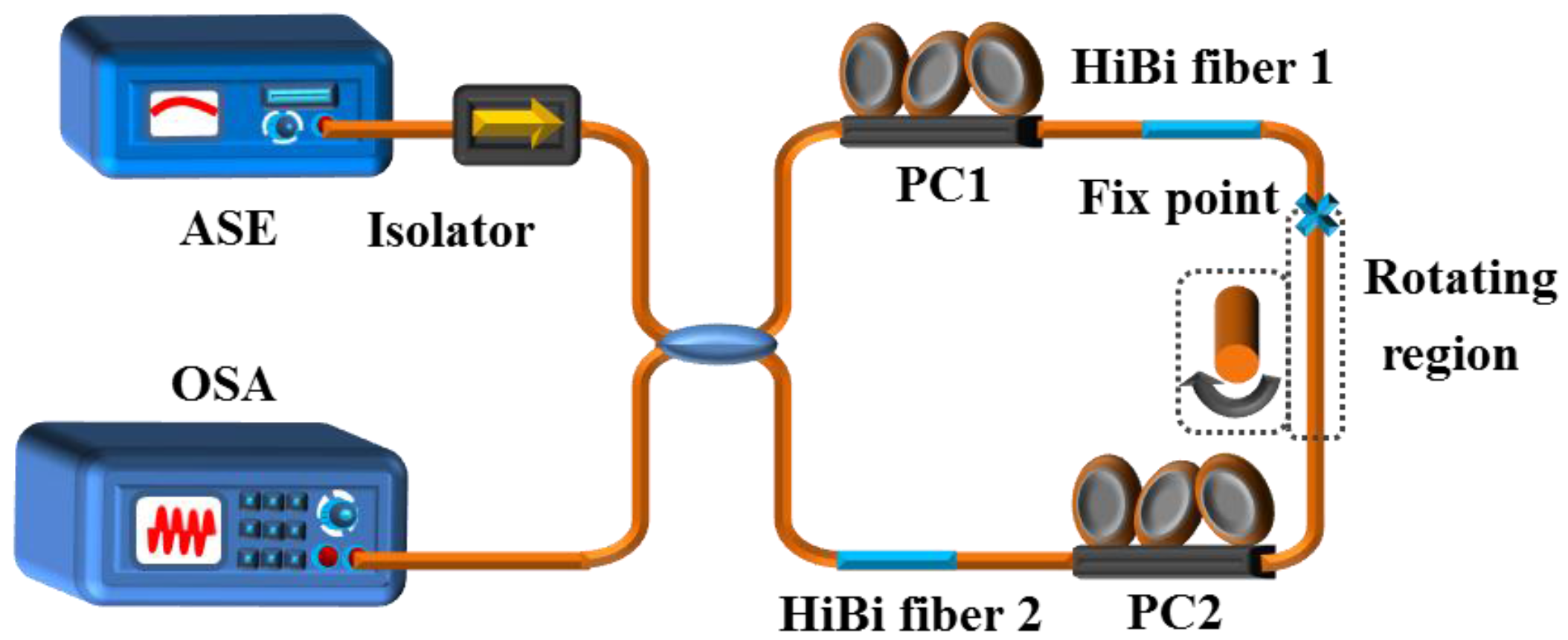
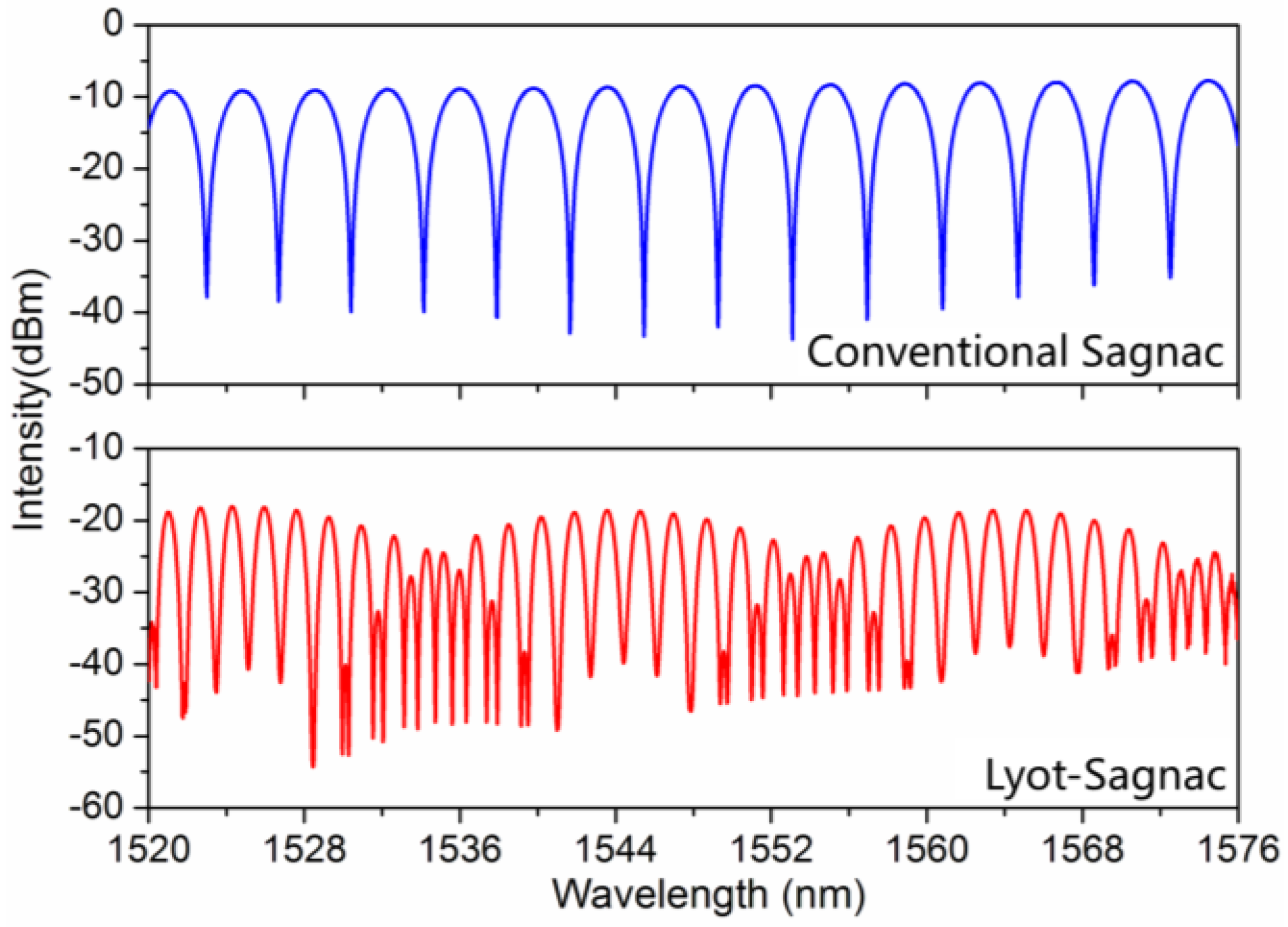
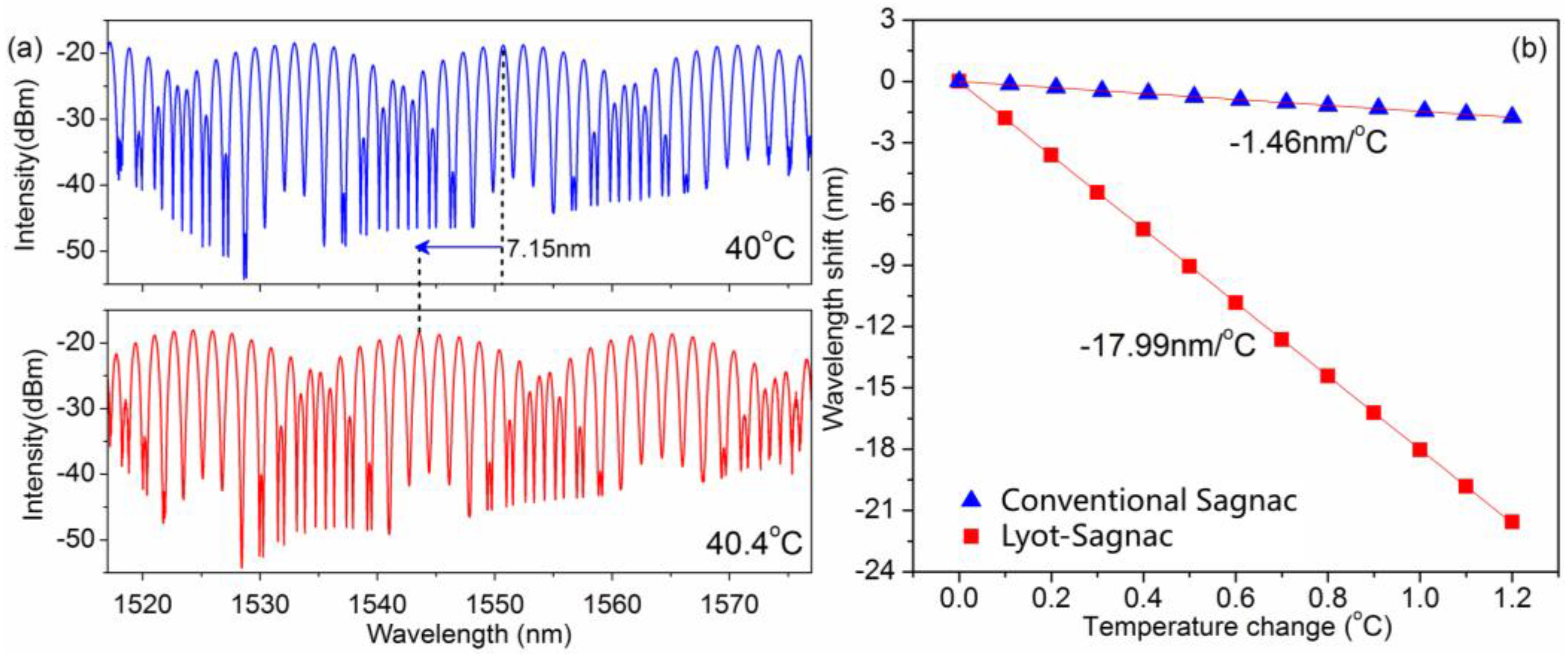

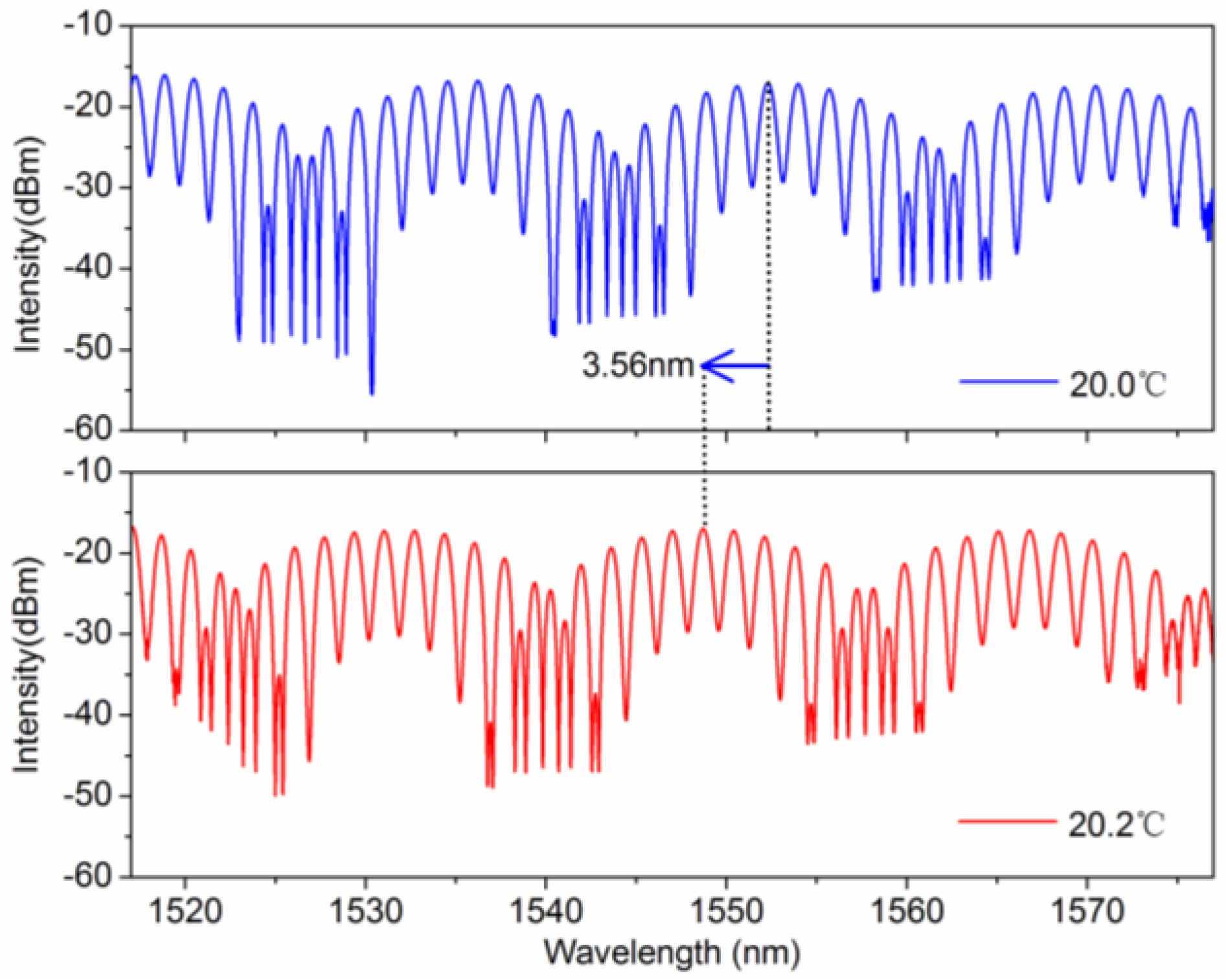
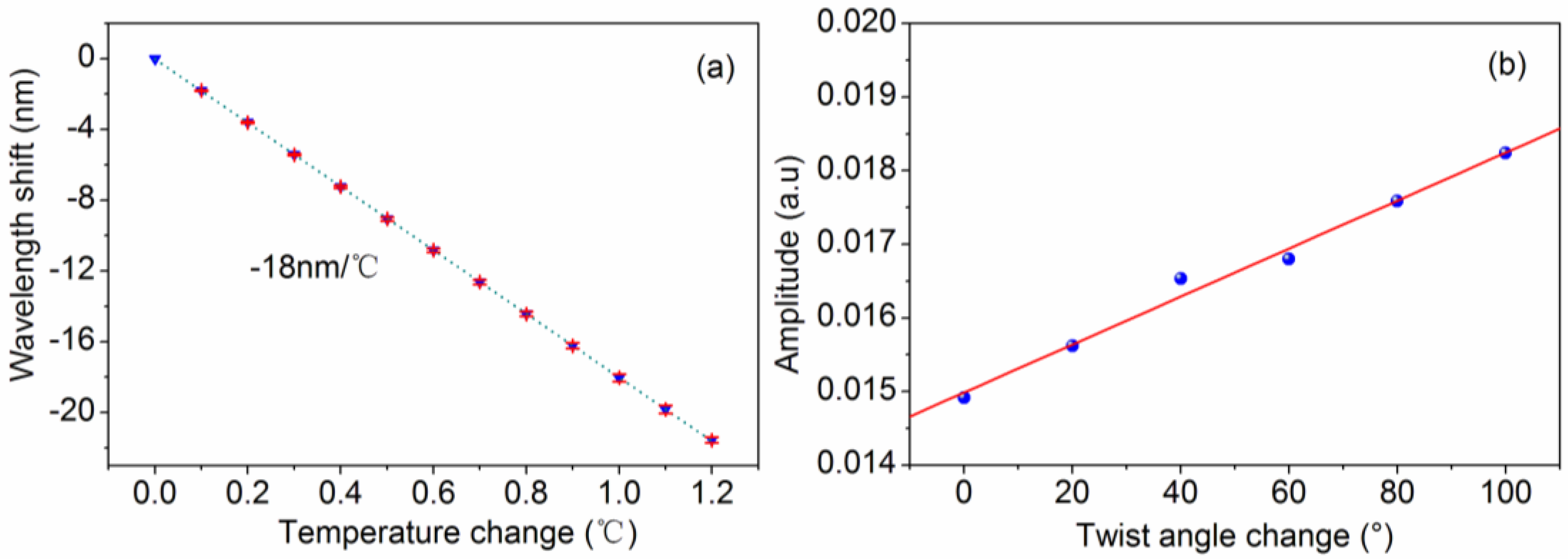
© 2016 by the authors; licensee MDPI, Basel, Switzerland. This article is an open access article distributed under the terms and conditions of the Creative Commons Attribution (CC-BY) license (http://creativecommons.org/licenses/by/4.0/).
Share and Cite
Shao, L.-Y.; Zhang, X.; He, H.; Zhang, Z.; Zou, X.; Luo, B.; Pan, W.; Yan, L. Optical Fiber Temperature and Torsion Sensor Based on Lyot-Sagnac Interferometer. Sensors 2016, 16, 1774. https://doi.org/10.3390/s16101774
Shao L-Y, Zhang X, He H, Zhang Z, Zou X, Luo B, Pan W, Yan L. Optical Fiber Temperature and Torsion Sensor Based on Lyot-Sagnac Interferometer. Sensors. 2016; 16(10):1774. https://doi.org/10.3390/s16101774
Chicago/Turabian StyleShao, Li-Yang, Xinpu Zhang, Haijun He, Zhiyong Zhang, Xihua Zou, Bin Luo, Wei Pan, and Lianshan Yan. 2016. "Optical Fiber Temperature and Torsion Sensor Based on Lyot-Sagnac Interferometer" Sensors 16, no. 10: 1774. https://doi.org/10.3390/s16101774
APA StyleShao, L.-Y., Zhang, X., He, H., Zhang, Z., Zou, X., Luo, B., Pan, W., & Yan, L. (2016). Optical Fiber Temperature and Torsion Sensor Based on Lyot-Sagnac Interferometer. Sensors, 16(10), 1774. https://doi.org/10.3390/s16101774






